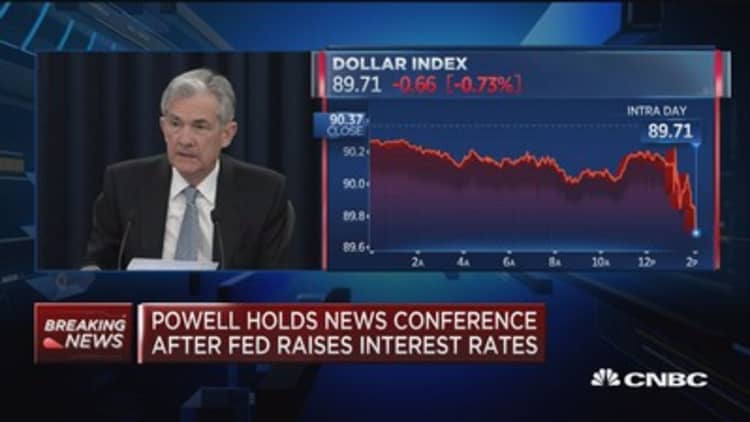
If Fed Chairman Jerome Powell was looking to distinguish himself from his predecessors, this week's events represented at least initial meaningful steps toward doing so.
A few points stood out from his first official meeting as head of the central bank: He is likely to focus more on data than theory; he's not going to be a slave to projections; and he's less, well, verbose than the market's come to expect, at least in recent history.
Importantly, time could tell that he also will be more hawkish about rates, confirming what many Fed watchers had expected.
"He certainly is more to the point, much less theoretical. That's nice just because it's different," said Joe LaVorgna, chief economist for the Americas at Natixis. "When there is a crisis at some point, Powell's communication skills may be an asset because he's so direct."
The knee-jerk reaction to the new Fed wasn't good: Thursday saw a market swoon, with drops in the major averages approaching 1.5 percent in morning trade. Investors flocked to safe haven bonds, despite a still-pervasive feeling that the Fed will be raising rates aggressively.
For years, the Fed had professed to be data dependent when in fact it was basing much of its decisions on models-based analyses that often seemed tone-deaf to the reality on the ground. Think, for instance, of when policymakers had indicated a 6.5 percent unemployment rate would be the basis for policy tightening, only to watch that level come and go without any action.
There was some of that on Wednesday as well: The Federal Open Market Committee indicated a slightly more hawkish bent despite essentially no change in its collective inflation forecast. That suggests a continued adherence to the Phillips curve, which posits that as unemployment declines, inflation should rise, a phenomenon that has not occurred during the economic recovery.
However, the market was tuned in more to Powell's words. He indicated, in a comparatively short 43-minute news conference, that he has limited interest in forecasting, or central bank verbosity.
"The committee made one decision, and that was to raise the federal funds rate by 25 basis points," Powell said during his first news conference, in response to a question about the "dot-plot" forecasts for interest rates from individual FOMC members.
The indication was clear: This is what we decided today, and it has little bearing on what happens tomorrow.
"That was Powell's most powerful sentence in the entire press conference," Nick Colas, co-founder of DataTrek Research, said in his daily market note. "The underlying message was one of process: Chair Powell made it clear that he is intellectually open to new information and will not be anchored by a 'Dot,' even if it is his own."
That's not to say the dots aren't important. The dot plot produced from the March meeting indicated that despite the lack of inflation pressures, the Powell Fed at this point looks to be at least marginally more aggressive with rate hike plans than the Janet Yellen Fed.
While the baseline forecast remains three rate hikes in 2018, excluding dots submitted by nonvoting members pushes that expectation into four moves for this year and perhaps more in the next two years.
The market is sensitive to a tighter Fed, as evidenced by the day-after market sell-off Thursday. The selling may have been rooted more in trade war fears, but nevertheless served as a cold reception to the market's first look at Powell in his new role.
"Our main takeaway is that the committee's views are evolving in line with the data and financial conditions," Goldman Sachs economists Spencer Hill and Jan Hatzius said in a note. "We would not rule out a faster pace in 2019 or continued increases into 2020, and we view the risks to our interest rate forecasts as broadly balanced."
For investors, it all means getting used to a new day in U.S. monetary policy, even if the differences at first are subtle.
"A policy shift is under way at the Federal Reserve," said Ryan Sweet, director of monetary policy research at Moody's Analytics. "While the Fed didn't signal a fourth rate hike this year, that change is coming."
WATCH: Powell says he's been surprised by low wage growth.



